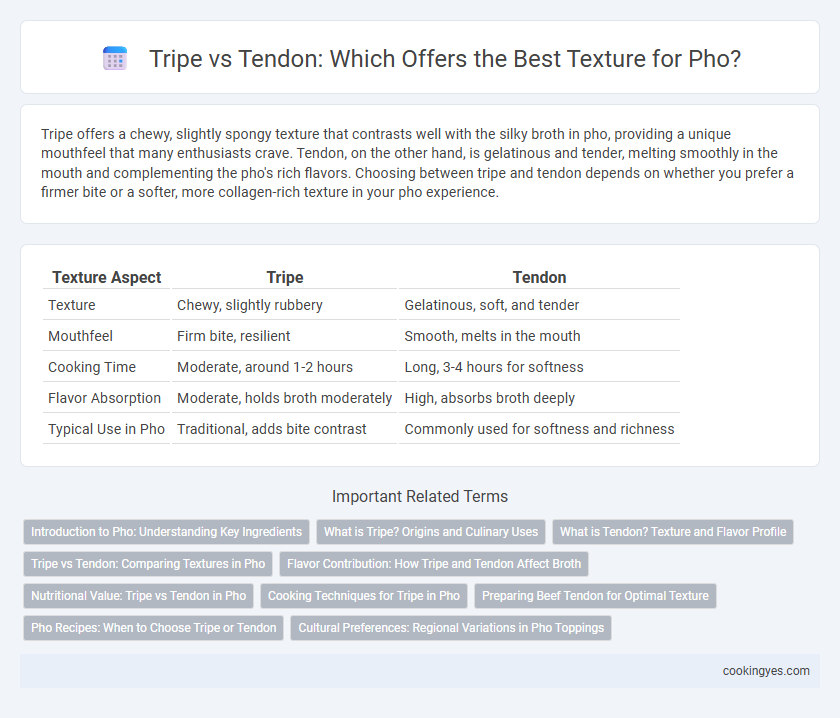Tripe offers a chewy, slightly spongy texture that contrasts well with the silky broth in pho, providing a unique mouthfeel that many enthusiasts crave. Tendon, on the other hand, is gelatinous and tender, melting smoothly in the mouth and complementing the pho's rich flavors. Choosing between tripe and tendon depends on whether you prefer a firmer bite or a softer, more collagen-rich texture in your pho experience.
Table of Comparison
| Texture Aspect | Tripe | Tendon |
|---|---|---|
| Texture | Chewy, slightly rubbery | Gelatinous, soft, and tender |
| Mouthfeel | Firm bite, resilient | Smooth, melts in the mouth |
| Cooking Time | Moderate, around 1-2 hours | Long, 3-4 hours for softness |
| Flavor Absorption | Moderate, holds broth moderately | High, absorbs broth deeply |
| Typical Use in Pho | Traditional, adds bite contrast | Commonly used for softness and richness |
Introduction to Pho: Understanding Key Ingredients
Tripe and tendon are essential ingredients that define the texture in pho, a traditional Vietnamese noodle soup. Tripe offers a chewy, slightly spongy texture that absorbs the rich beef broth, while tendon provides a softer, gelatinous feel that melts in the mouth. Selecting the right combination enhances the sensory experience, balancing firmness and tenderness in every bowl.
What is Tripe? Origins and Culinary Uses
Tripe is the edible lining from the stomachs of various farm animals, primarily cows, and is prized in Vietnamese pho for its chewy, slightly rubbery texture that contrasts with the softer tendon. Originating from traditional culinary practices in many cultures worldwide, tripe provides a rich, savory flavor and a unique mouthfeel that enhances pho's complex texture profile. Its preparation typically involves thorough cleaning and slow simmering, imparting a depth of taste that is distinct from the gelatinous, melt-in-your-mouth texture of tendon in pho.
What is Tendon? Texture and Flavor Profile
Tendon in pho is the tendon tissue from beef, known for its gelatinous and slightly chewy texture that softens when simmered. It provides a rich, collagen-packed bite that contrasts with the firmer, more fibrous texture of tripe. The flavor profile of tendon is mild yet deeply savory, absorbing pho broth flavors while adding a unique mouthfeel that enhances the overall pho experience.
Tripe vs Tendon: Comparing Textures in Pho
Tripe offers a chewy, slightly crisp texture that contrasts with the soft, gelatinous feel of tendon in pho. While tripe provides a subtle crunch and a firmer bite, tendon melts smoothly in the mouth, enhancing the broth's richness. Choosing between tripe and tendon depends on whether you prefer a more robust chew or a tender, silky texture in your pho experience.
Flavor Contribution: How Tripe and Tendon Affect Broth
Tripe adds a subtle, earthy flavor and a slightly chewy texture that enriches the pho broth with depth and complexity. Tendon, when slow-cooked, breaks down to release gelatin, contributing a silky mouthfeel and a rich, savory umami that enhances the broth's body. Combining both ingredients balances the broth's flavor profile, offering a contrast between tender gelatinous notes and tender yet firm meatiness.
Nutritional Value: Tripe vs Tendon in Pho
Tripe in pho offers a high protein content with low fat, making it a lean source of essential amino acids and vitamins like B12 and zinc, which support immune function and energy metabolism. Tendon, while lower in protein, is rich in collagen that promotes joint health and skin elasticity due to its gelatinous texture after cooking. Choosing tripe adds more nutritional density to pho, whereas tendon provides benefits tied to connective tissue health and a unique mouthfeel.
Cooking Techniques for Tripe in Pho
Tripe in pho requires thorough cleaning and slow simmering for several hours to achieve a tender, slightly chewy texture that absorbs the rich broth flavors. Precise timing is essential to avoid toughness, with blanching used initially to remove impurities and enhance the final dish's clarity. Comparatively, tendon demands longer cooking to reach gelatinous softness, making tripe a preferred choice for those seeking a firm yet tender bite in pho.
Preparing Beef Tendon for Optimal Texture
Beef tendon requires slow simmering for at least 3 to 4 hours to achieve a tender, gelatinous texture that complements pho broth. Trimming excess fat and thoroughly cleaning the tendon before cooking ensures a clean taste and improves the mouthfeel. Properly prepared tendon offers a chewy yet soft bite, contrasting the firmer, slightly rubbery texture of tripe in traditional pho.
Pho Recipes: When to Choose Tripe or Tendon
Pho recipes call for choosing between tripe and tendon based on desired texture and cooking time. Tripe offers a chewy, slightly spongy texture that absorbs the broth's flavor well, ideal for quicker cooking. Tendon requires longer simmering to become tender and provides a rich, gelatinous bite that enhances the pho's mouthfeel.
Cultural Preferences: Regional Variations in Pho Toppings
Tripe and tendon each offer distinct textures that cater to regional preferences in pho across Vietnam. Northern regions traditionally emphasize the chewy, gelatinous quality of tendon, enhancing the broth's richness, while Southern pho often features tender, mildly flavored tripe that complements the sweeter, herb-infused broth. These cultural variations highlight the importance of texture in shaping the authentic pho experience tailored to local tastes and culinary customs.
Tripe vs tendon for pho texture Infographic

 cookingyes.com
cookingyes.com